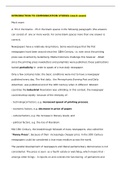Class notes
Summary / Extensive lecture notes - Evolutionary Psychology
- Course
- Institution
This document includes extensive and well elaborated notes of all the lectures of Evolutionary Psychology, given by Rob Nelissen. This document gives enough information to understand the subjects and needed interpretation for the exam. The lecture notes form a good summary of this course. I passed ...
[Show more]












